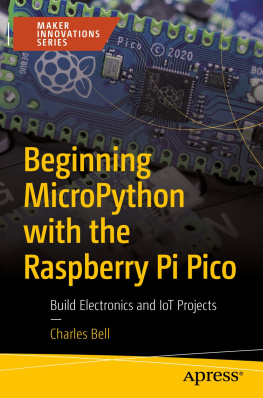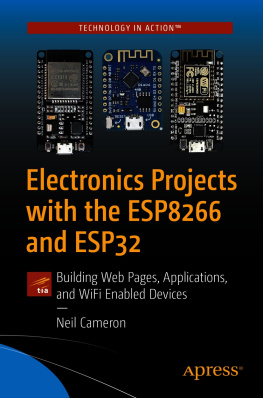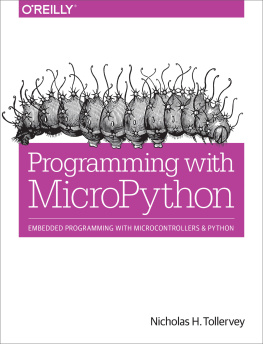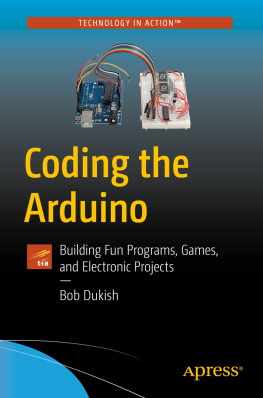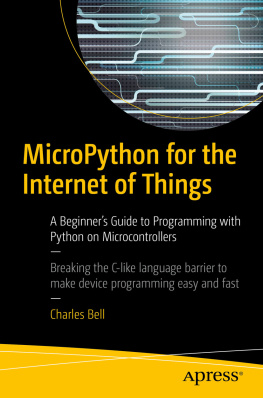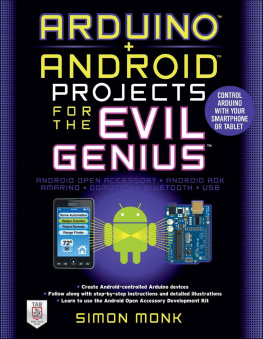Shiro - EXPLORE ESP32 MICROPYTHON: Python Coding, Arduino Coding, Raspberry Pi, ESP8266, IoT Projects, Android Application Projects
Here you can read online Shiro - EXPLORE ESP32 MICROPYTHON: Python Coding, Arduino Coding, Raspberry Pi, ESP8266, IoT Projects, Android Application Projects full text of the book (entire story) in english for free. Download pdf and epub, get meaning, cover and reviews about this ebook. year: 2021, genre: Home and family. Description of the work, (preface) as well as reviews are available. Best literature library LitArk.com created for fans of good reading and offers a wide selection of genres:
Romance novel
Science fiction
Adventure
Detective
Science
History
Home and family
Prose
Art
Politics
Computer
Non-fiction
Religion
Business
Children
Humor
Choose a favorite category and find really read worthwhile books. Enjoy immersion in the world of imagination, feel the emotions of the characters or learn something new for yourself, make an fascinating discovery.

- Book:EXPLORE ESP32 MICROPYTHON: Python Coding, Arduino Coding, Raspberry Pi, ESP8266, IoT Projects, Android Application Projects
- Author:
- Genre:
- Year:2021
- Rating:3 / 5
- Favourites:Add to favourites
- Your mark:
- 60
- 1
- 2
- 3
- 4
- 5
EXPLORE ESP32 MICROPYTHON: Python Coding, Arduino Coding, Raspberry Pi, ESP8266, IoT Projects, Android Application Projects: summary, description and annotation
We offer to read an annotation, description, summary or preface (depends on what the author of the book "EXPLORE ESP32 MICROPYTHON: Python Coding, Arduino Coding, Raspberry Pi, ESP8266, IoT Projects, Android Application Projects" wrote himself). If you haven't found the necessary information about the book — write in the comments, we will try to find it.
Shiro: author's other books
Who wrote EXPLORE ESP32 MICROPYTHON: Python Coding, Arduino Coding, Raspberry Pi, ESP8266, IoT Projects, Android Application Projects? Find out the surname, the name of the author of the book and a list of all author's works by series.
EXPLORE ESP32 MICROPYTHON: Python Coding, Arduino Coding, Raspberry Pi, ESP8266, IoT Projects, Android Application Projects — read online for free the complete book (whole text) full work
Below is the text of the book, divided by pages. System saving the place of the last page read, allows you to conveniently read the book "EXPLORE ESP32 MICROPYTHON: Python Coding, Arduino Coding, Raspberry Pi, ESP8266, IoT Projects, Android Application Projects" online for free, without having to search again every time where you left off. Put a bookmark, and you can go to the page where you finished reading at any time.
Font size:
Interval:
Bookmark:
EXPLORE
ESP32 MICROPYTHON
Python Coding, Arduino Coding, Raspberry Pi, ESP8266, IoT Projects, Android Application Projects
By
Akira Shiro
TABLE OF CONTENTS
Programming is something that every modern makers should have some grasp. Figuring out exactly what program is best for your particular purpose can be half of the battle. I've had a chat previously about programming, but as an overview programming is simply the process of creating instructions for a computing device to comprehend and execute. These instructions are referred to as a software. Once the software program is run, the computing device will perform the specified task. The programming language is a set of commands, directives and other syntaxes, which gives you a vocabulary to create these software programs. Now Python and micro path and our power house programming languages. Each language can support your programming needs to almost the limits of your imagination. Both languages are transportable open source growing in popularity, comparatively, easy to use. And free. They also have similar syntax, keywords and operators. So how exactly do they differ from each other? Get up, get up, get up, get the fuck up. The biggest factor is that Python because of its intensive processing demands requires a full-sized computer. Laptop or cloud server to run effectively in Harrison, the hardware requirements of micro path and up orders of magnitude lower. This means macrobiotic can operate effectively on microcontrollers and microprocessors to clarify a microcontroller is a compact integrated circuit designed to govern a specific operation inside an embedded system to the table. I brought an Arduino UNO. Which is a perfect example of this. A microprocessor on the other hand is an integrated circuit that contains all the functions of a central processing unit of a computer, which includes an operating system. Demonstrate this. I brought to the table, a raspberry PI full model B eight gigabytes, which is a perfect example of a microprocessor. Both these devices can easily fit in the Palm of your hands and encourage and makers, rainbows of creativity. Now with most recent modern technology, this concept of micro Python for credit card size computers, whereas Python for lodge, computational devices. This concept is just not become so cut and dry. Some micro processes have become so powerful. They can functionally run Python. The newest rush reply for model B eight. Gigabytes is a perfect example. So does it take to make a streamlined slimmed down Python? Start by ripping out, hates the libraries leaving only a subset of library. A module is a Python object with an arbitrarily named attribute, which you can bind and reference. Simply a module is a file consisting of Python code. A library is a collection of a whole bunch of these modules. Furthermore, of the few libraries left, remove unnecessary functions in classes that come with Python. A function is a bulk of code, which only runs when it's. Clauses are essentially a template to determine variables and functions of objects. Objects are simply collections of data. Some features that will not cater well to constraint systems also removed. And some freedoms with syntax are eliminated. This is a simplification of what Damian George, an Australian program and physicist did in 2014. Turning Python into what we see today as micro Python. These changes mean micro Python is an extremely compact programming language takes up less than a megabyte of storage space. And underload utilizes only around 16 kilobytes of Ram. If you're interested in each and every detail at a highlight. Come take a look at the write-up on this topic, where I go very deep into this jumping into the computer. You can see on one of the core electronic website, here's a particular write-up. And if you jump on deep dive on differences between Python and micro Python, it will talk about the real nitty gritty details. Between path and a micro Python, both Python and micro Python, programming languages are free to download and use jumping over here.
You can see where you can download Python and jumping over here. You can see where you can download micro Python. They also open source so that it gives individuals the freedom to modify, contribute, and propose improvement. There are also online. Browser-based emulators for both Python and micro path. And so you don't even need to download anything to experience these languages. Also, if you're interested in micro bullets that will run micro Python brilliantly, come back to that webpage that I showed you before and under micro Python compatible bullets, you'll see a whole bunch of micro bullets that will run Python.
This is indeed the coveted just before lunch slot. Um, so if any of you feel yourself kind of slowly slumping over, I won't take it personally. It's. The way these things go. So I'm here to talk about the ESP 32 port of micro Python. U m, we've, we've talked about, um, micro Python as a, as a project overall from Damien talked about some specific application of micro parts and is a great way to prototype stuff. I'm Anna and I'm coming, you're talking about this ESP 32 port, which I'm really, really excited about. So it's great to be able to come and talk about it to you. Um, There's some background about micro Python, but it's probably not all that necessary since we've already kind of covered that fairly well. But for anyone who wasn't here before, it's a reimplementation of Python. I'd say it's a Python because it's very much like all the other pythons. And if you know how to program Python, you know how to program Miko Pathan, it runs on small controller boards of various kinds, including the PI board and the micro bit. And these ESP 82 66 systems on a chip that have become very popular recently. And now it's got a port to the ESP 32.

What are those chips? An ESP 82 66, which you can't really see because it's all. Pretty horrible, um, is a small system on a chip featuring on board wifi and various other peripherals. Um, they kind of first, uh, actually, before I get onto that, they're made by a company called expressive who are a fabulous manufacturer. Um, I think the thing that makes espresso particularly interesting as the, one of the first of the Chinese manufacturers to really embrace the open source world, they're very active in a, an open source community. They're very supportive of our open source development efforts. Um, and that's really great. And I, um, I think that's been a great advantage for them as well. Uh, the 82 66 became a real enthusiastic stream, partly because it's very powerful thought it is partly cause you could get them for like $2. Um, And the has learned a lot out of that. They've taken a lot of inspiration from the things people have done with 80 to 60 Sixers, many of them fairly silly, but nonetheless people have had a lot of fun with them. People have tried a lot of things. People have put a lot of interesting stuff together and the company has been able to learn from that and combine a lot of that knowledge into the ESP 32.

So as I mentioned before, the HQ 66 came to prominence, um, as a. Uh, wifi, accessory for Arduinos and things like that until somebody's looking at the spec sheets realized it was well, several times as powerful as the Arduino, it was helping out. And that this relationship seemed a little silly and that perhaps we should just develop directly for the 82 66 instead, it's got a reasonably nice, uh, sea-based um, SDK. It's not that hard to get started in. But there is a bit of a barrier to entry there. Um, and thankfully someone Damien ported, a micro Python across to it. I discovered this, I just started developing some stuff ready to 66. I got really fired up about it after Linux con Jalong. I think it was got really excited about this whole 82 66 chip and writing. See again, and I hadn't written C in ages and. Just as the novelty and excitement of writing, see again, was starting to wear off. My copay thing came off out. So I let upon micro Python and went, this is the coolest thing ever. Um, and I got more into it and I got more into it. I got really excited about it. And then I started working on it sort of just with it. And then I started running C again to work. And so the cycle, but never mind. So yeah, following up on the 82 66, there's now the ESP. 32, as I said before, it's taken a lot of inspiration from what people have done. It's more powerful. Again, there's two CPU because instead of one CPU core, there's an ultra low power processor, which is a really cool little accessory. That's really just like a, uh, uh, very small, very slowly. It's just got enough power to wake up the other CPS, if something interesting is happening and if you're running on a battery, that's a really important thing. Runs a slightly faster clock rate. Most importantly to us, it's got a heap more Ram five 20 K does not sound like a great amount of Ram to a modern developer. Um, I installed some software, uh, yesterday to do the machine learning things that downloaded. Um, I wasn't an a half a terabyte or something of data onto my laptop just to install. Um, but you. It's enough to be usable for, for Python, for micro Python, one 60 K headroom on the ADC. 66 isn't is plenty enough to run micro Python, but your applications tend to bump into that limit fairly easily. The five 20 K gives us a bit of bit of breathing room. It's also got a bigger flash, which is really nice. These devices are much less powerful than something like an RP zero w which is the next sort of thing up that you might be thinking of. That's the wireless PI zero, uh, that's a much more powerful CPU running at a faster rate. It's got a lot more memory. It's got a lot more ability to expand with, with flash and things like that. But yeah, provide a little middle ground. It's an interesting market segment. That's kind of opened up between the eight bit sort of Arduino AVR world and that RPO world. Um, the 32 is very interesting because it features as well as the wifi that you know about.
Font size:
Interval:
Bookmark:
Similar books «EXPLORE ESP32 MICROPYTHON: Python Coding, Arduino Coding, Raspberry Pi, ESP8266, IoT Projects, Android Application Projects»
Look at similar books to EXPLORE ESP32 MICROPYTHON: Python Coding, Arduino Coding, Raspberry Pi, ESP8266, IoT Projects, Android Application Projects. We have selected literature similar in name and meaning in the hope of providing readers with more options to find new, interesting, not yet read works.
Discussion, reviews of the book EXPLORE ESP32 MICROPYTHON: Python Coding, Arduino Coding, Raspberry Pi, ESP8266, IoT Projects, Android Application Projects and just readers' own opinions. Leave your comments, write what you think about the work, its meaning or the main characters. Specify what exactly you liked and what you didn't like, and why you think so.

